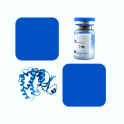
- Remove this product from my favorite's list.
- Add this product to my list of favorites.
Products
Newsletter
 |  |  |  |  |  |

Background
Prolactin (gene name PRL) is a secreted neuroendocrine pituitary hormone that acts primarily on the mammary gland to promote lactation, but has pleiotropic effects in both males and females. Prolactin is synthesized as a prohormone. Following cleavage of the signal peptide, the length of the mature hormone is between 194 and 199 amino acids, depending on species. Hormone structure is stabilized by three intramolecular disulfide bonds. Excessive secretion of prolactin - hyperprolactinemia - is a relative common disorder in humans. This condition has numerous causes, including prolactin-secreting tumors and therapy with certain drugs. The prolactin receptor (gene name PRLR) is a transmembrane type I glycoprotein that belongs to the cytokine hematopoietic receptor family. Expression of the prolactin receptor is widespread. Each prolactin molecule is thought to bind two receptor molecules.
Source
Recombinant Human Prolactin, Mouse IgG2a Fc Tag, low endotoxin (PRN-H5257) is expressed from human 293 cells (HEK293). It contains AA Leu 29 - Cys 227 (Accession # Q5THQ0-1).
Predicted N-terminus: Leu 29
Molecular Characterization
This protein carries a mouse IgG2a Fc tag at the C-terminus
The protein has a calculated MW of 49.8 kDa. The protein migrates as 50-55 kDa when calibrated against Star Ribbon Pre-stained Protein Marker under reducing (R) condition (SDS-PAGE) due to glycosylation.
Endotoxin
Less than 0.1 EU per μg by the LAL method.
Purity
>95% as determined by SDS-PAGE.
Formulation
Lyophilized from 0.22 μm filtered solution in Tris with Glycine, Arginine and NaCl, pH7.5 with trehalose as protectant.
Reconstitution
Please see Certificate of Analysis for specific instructions.
For best performance, we strongly recommend you to follow the reconstitution protocol provided in the CoA.
Storage
For long term storage, the product should be stored at lyophilized state at -20°C or lower.
Please avoid repeated freeze-thaw cycles.
This product is stable after storage at:
-20°C to -70°C for 12 months in lyophilized state;
-70°C for 3 months under sterile conditions after reconstitution.
Bioactivity
Please refer to product dat asheet.
(1) "Involvement of somatotrophic hormones in the postpartum regulation of ovarian activity in mares"
Melchert, Aurich, Ertl et al
Domest Anim Endocrinol (2024) 88, 106852
(2) "The diagnosis and prevalence of hypoprolactinemia in patients with panhypopituitarism and the effects on depression and sexual functions"
Uzun, Karaca, Hacioğlu et al
Pituitary (2024)
(3) "Clinical Impact of New Reference Intervals for the Roche Prolactin II Immunoassay"
Earll, Javorsky, Sarvaideo et al
J Endocr Soc (2024) 8 (6), bvae069
Showing 1-3 of 55420 papers.
Follow us